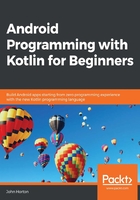
Summary
In this chapter, we built aesthetically pleasing CardView layouts and put them in a ScrollView layout so that the user can swipe through the content of the layout a bit like browsing a web page. To conclude the chapter, we launched a tablet emulator and saw that we are going to need to get smart with how we design our layouts if we want to cater for different device sizes and orientations. In Chapter 24, Design Patterns, Multiple Layouts, and Fragments, we will begin to take our layouts to the next level and learn how to cope with such a diverse array of devices by using Android Fragments.
Before we do so, however, it will serve us well to learn more about Kotlin and how we can use it to control our UI and interact with the user. This will be the focus of the next seven chapters.
Of course, the elephant in the room at this point is that, despite learning lots about layouts, project structure, the connection between Kotlin and XML, and much more besides, our UIs, no matter how pretty, don't actually do anything! We need to seriously upgrade our Kotlin skills while also learning more about how to apply them in an Android context.
In the next chapter, we will do exactly that. We will look at how we can add Kotlin code that executes at exactly the moment we need it to by working with the Android Activity lifecycle.